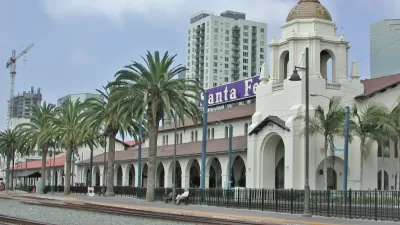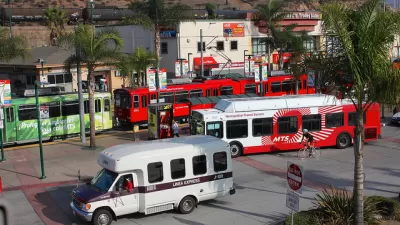Is California's High-Speed Rail (HSR) a "boondoggle" for the state, as its critics assert, or just a boondoggle for omitted cities? How should such cities deal with omission from HSR? San Diego is a case in point.

Land use attorney Bill Adams looks at San Diego's omission from California High-Speed Rail Phase 1, and a very uncertain and far-off Phase 2, in the context of the region's history and reaches some disturbing conclusions:
"In the late 1800s, San Diego lost the race with Los Angeles to become the western terminus of a transcontinental railroad. As a result, despite some sound accomplishments, San Diego never matched its northern rivals in economic growth & prosperity. . ."
"Now comes San Diego’s omission from “Phase 1″ of the High Speed Rail project. Upon completion of HSR, rail travel between Los Angeles and San Francisco Bay area will take the same or less time than between San Diego and Los Angeles despite being more than three times further apart. . ."
"Many of the City’s elected representatives have focused more on concerns about the overall economics of the project (many calling it a 'boondoggle'), while others have remained ambivalent."
However, Bill Adams goes on to note that there may be opportunities in the omission from Phase 1 if there is the political will to pursue them:
"[C]ould San Diego’s omission from the HSR Phase 1 have been made into a blessing, or at least largely offset, by securing even greater investment in the existing rail corridor? Perhaps the corridor could even be made to accommodate the 'higher-speed' Acela Express range of 80 to 110 mph? Perhaps a much needed direct airport-to-airport connection could be accomplished. After all, the existing rail route is far shorter and more direct, straight, and shorter than that proposed for the HSR Phase 2 route winding its way through the Inland Empire region. . . it begs the question what might be accomplished with more imperative and support?"
FULL STORY: San Diego’s Railroad Deja Vu

Study: Maui’s Plan to Convert Vacation Rentals to Long-Term Housing Could Cause Nearly $1 Billion Economic Loss
The plan would reduce visitor accommodation by 25,% resulting in 1,900 jobs lost.

North Texas Transit Leaders Tout Benefits of TOD for Growing Region
At a summit focused on transit-oriented development, policymakers discussed how North Texas’ expanded light rail system can serve as a tool for economic growth.

Why Should We Subsidize Public Transportation?
Many public transit agencies face financial stress due to rising costs, declining fare revenue, and declining subsidies. Transit advocates must provide a strong business case for increasing public transit funding.

Invasive Insect Threatens Minnesota’s Ash Forests
The Emerald Ash Borer is a rapidly spreading invasive pest threatening Minnesota’s ash trees, and homeowners are encouraged to plant diverse replacement species, avoid moving ash firewood, and monitor for signs of infestation.

Agreement Keeps NYC Congestion Pricing Alive Through Summer
The tolling program will continue while a court considers the city’s lawsuit against the Trump administration.

Private Donations Propel Early Restoration of Palisades Playground
Los Angeles has secured over $1.3 million in private funding to restore the Pacific Palisades playground months ahead of schedule, creating a modern, accessible space that supports community healing after recent wildfires.
Urban Design for Planners 1: Software Tools
This six-course series explores essential urban design concepts using open source software and equips planners with the tools they need to participate fully in the urban design process.
Planning for Universal Design
Learn the tools for implementing Universal Design in planning regulations.
Ascent Environmental
Borough of Carlisle
Institute for Housing and Urban Development Studies (IHS)
City of Grandview
Harvard GSD Executive Education
Toledo-Lucas County Plan Commissions
Salt Lake City
NYU Wagner Graduate School of Public Service




























